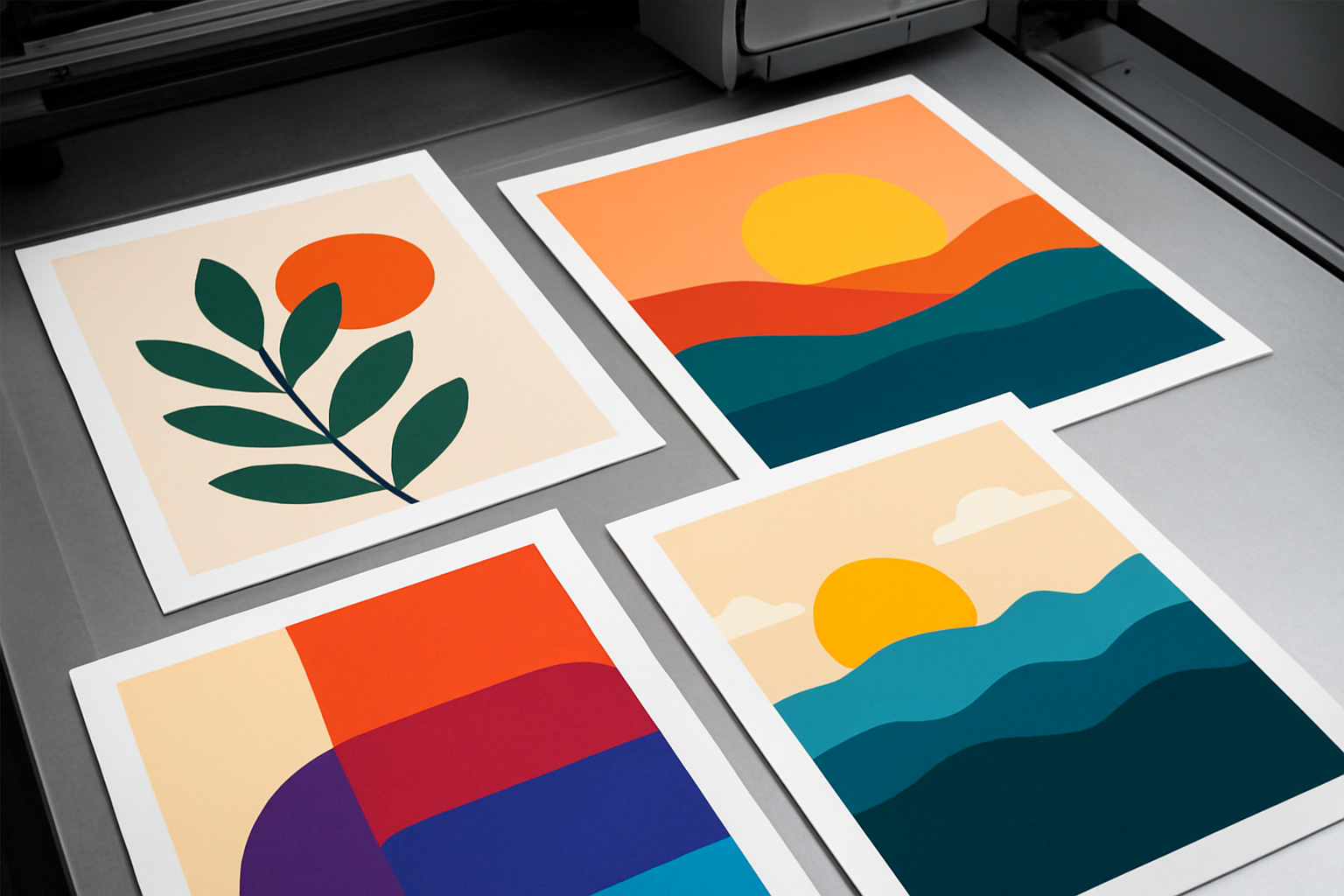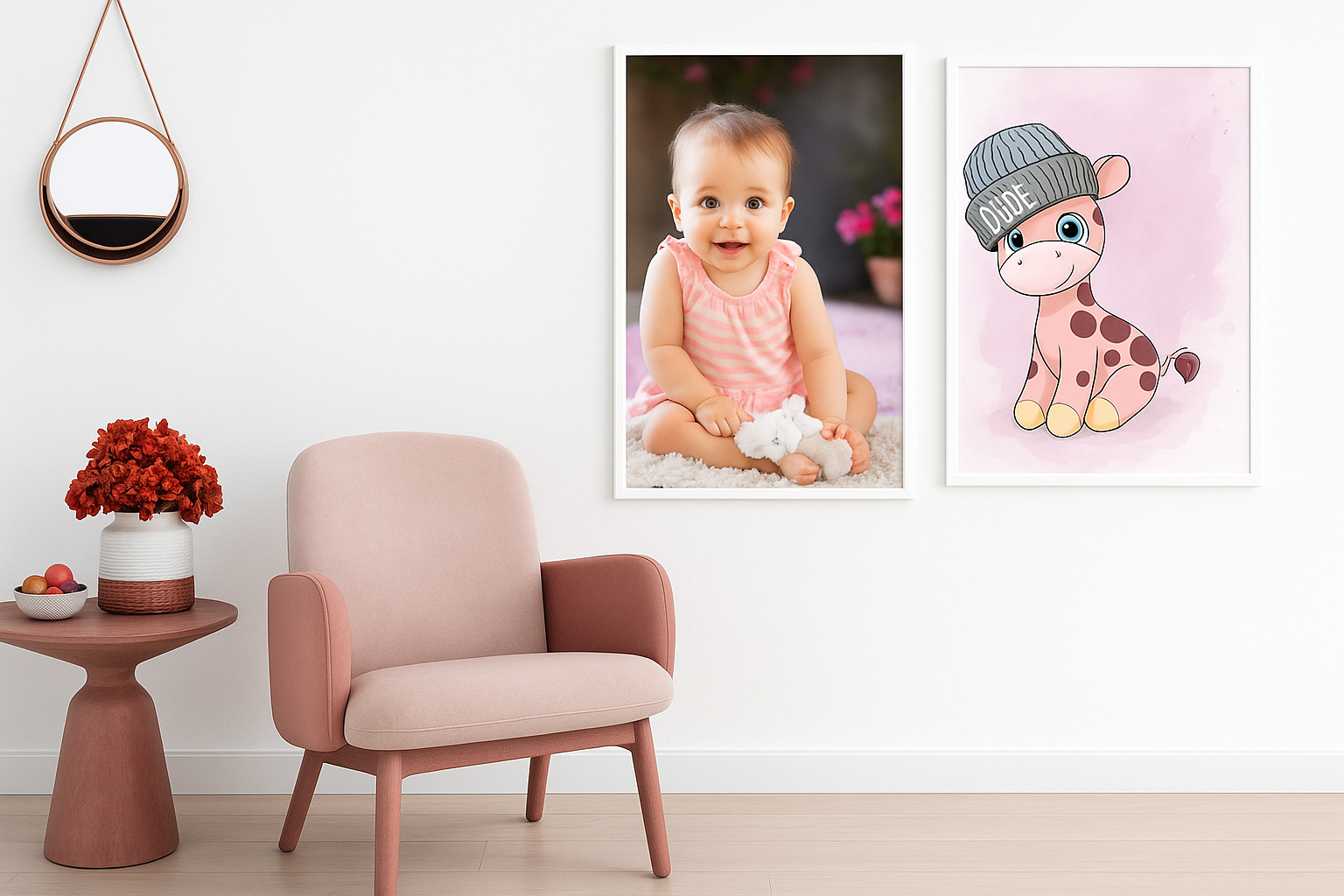What Is Canvas Made Of?

You see canvas in more places than you think. Artists paint on it. Brands use it for bags, shoes, and tents. Decorators rely on it for canvas prints and wall art.
People choose canvas because it feels strong and lasts long. But what makes it so durable? What materials go into it? Why do some types feel soft while others feel rough?
In this blog, we answer those questions. We explain what canvas fabric is, what it's made of, and why it suits so many everyday uses.
What Is Canvas Fabric, Really?
Canvas is a thick, tightly woven fabric known for its strength and durability. It usually comes from cotton, linen, or a blend with synthetic fibers. The threads cross over each other in a plain weave, which creates a smooth yet sturdy surface.
This fabric feels firm and slightly textured. It doesn't stretch much over time, which makes it ideal for structured products. You can fold it, sew it, or stretch it over a frame without losing shape. It holds up well under weight, pressure, or constant use.
Because of these qualities, people often choose canvas for items that need to last. It resists tearing, stays firm over time, and handles rough handling better than many other fabrics.
What Is Canvas Material Made Of?
Canvas is usually made from cotton, linen, or a cotton-polyester blend. These materials are tightly woven to create a durable, heavy fabric. Cotton is soft and breathable. Linen feels stronger and more textured. Polyester blends add strength, reduce shrinkage, and resist moisture.
Let’s look at each type more closely:
1. Cotton Canvas
- Made from 100% cotton fibers
- Soft, flexible, and easy to handle
- Breathable and absorbs dye well
- Common in bags, shoes, art prints, and fabric decor
2. Linen Canvas
- Made from flax plant fibers
- Coarser and stiffer than cotton
- Holds shape better and lasts longer
- Often preferred for painting and premium textiles
3. Polyester-Cotton Blend
- Mix of natural cotton and synthetic polyester
- Tougher, wrinkle-resistant, and longer-lasting
- More water-resistant than pure cotton or linen
- Ideal for outdoor use, upholstery, and high-wear items
Natural vs Synthetic Canvas
|
Feature |
Cotton/Linen (Natural) |
Poly-Cotton Blend (Synthetic) |
|
Texture |
Softer or coarse (linen) |
Smooth and firm |
|
Durability |
Moderate to high |
Very high |
|
Breathability |
Excellent |
Moderate |
|
Moisture Resistance |
Low |
High |
|
Eco-Friendly |
Yes |
Less so |
|
Cost |
Slightly higher |
More affordable |
Natural canvas feels breathable and eco-conscious. Blended canvas handles stress, moisture, and wear better. The best choice depends on what you need it for.
Is Canvas a Natural or Synthetic Fabric?
Canvas can be both. Traditionally, manufacturers made canvas using natural fibers like cotton or linen. Today, many canvas fabrics are blends of natural and synthetic fibers.
This shift often causes confusion. People see canvas and assume it’s always cotton, but that’s not the case anymore. Polyester is commonly mixed with cotton to create stronger, more durable fabric.
Blended canvas improves water resistance and reduces shrinking. It also stretches less and lasts longer in outdoor or high-use settings. However, it feels less breathable than 100% cotton or linen.
Types of Canvas Fabrics Explained
Canvas comes in different types based on weave, fiber mix, and finishes. Each serves a specific purpose.
1. Plain Canvas
- Standard tight weave
- Lightweight to medium weight
- Used in simple bags, shoes, or crafts
2. Duck Canvas
- Tighter and smoother weave than plain canvas
- Feels heavier and more structured
- Used in heavy-duty workwear, upholstery, and durable bags
3. Waxed Canvas
- Regular canvas coated with wax
- Water-resistant and rugged
- Used in outdoor gear, jackets, and backpacks
4. Blended Canvas
- Mix of cotton and polyester
- More durable and wrinkle-resistant
- Ideal for digital printing, décor, and outdoor fabrics
Quick Canvas Type Comparison Table
|
Type |
Texture |
Weight |
Key Feature |
Best Used For |
|
Plain Canvas |
Slightly rough |
Light–medium |
Basic weave |
Bags, crafts, shoes |
|
Duck Canvas |
Smooth, dense |
Medium–heavy |
Durable and strong |
Workwear, upholstery |
|
Waxed Canvas |
Waxy, stiff |
Heavy |
Water-resistant surface |
Jackets, outdoor bags, tarps |
|
Blended Canvas |
Smooth, flexible |
Light–heavy |
Durable and cost-effective |
Printing, covers, décor |
How Is Canvas Fabric Made?
The process of making canvas involves several key steps:
- Harvesting: Cotton or flax plants are harvested for their fibers.
- Spinning: The raw fibers are cleaned and spun into long threads or yarns.
- Weaving: These yarns are woven using a plain weave. Each thread alternates over and under, creating a tight and balanced structure.
- Finishing: The fabric may go through treatments such as waxing, dyeing, or coating, depending on its intended use.
Result? A tough, stable canvas fabric ready for various applications, from art to industrial gear.
What Does GSM Mean in Canvas?
GSM stands for grams per square meter. It measures fabric weight and thickness.
Higher GSM means the fabric is heavier, thicker, and often stronger. Lower GSM indicates a lighter, more flexible canvas.
GSM Weight Guide:
- Lightweight Canvas (150–250 GSM): Thin and flexible. Used in linings, basic totes, and indoor prints.
- Medium Weight Canvas (300–400 GSM): Balanced thickness and strength. Ideal for everyday bags, shoes, aprons, and banners.
- Heavyweight Canvas (500+ GSM): Thick, stiff, and highly durable. Perfect for outdoor use, tents, upholstery, and protective covers.
Why it matters:
GSM helps you pick the right canvas based on strength, flexibility, and purpose. For prints, medium to heavy GSM offers the best balance of structure and image clarity.
How to Identify Genuine Canvas Material?
Not sure if it's real canvas? These simple checks can help you figure it out.
1. Feel the Fabric
Genuine canvas feels firm and slightly coarse. It doesn’t stretch much and has a solid weight when you hold it. If it feels too smooth or thin, it’s likely a synthetic blend.
2. Look at the Weave
Real canvas has a tight, plain weave. You can usually see the crisscross pattern if you look closely. The threads run evenly and don’t shift easily when you press or pinch the fabric.
3. Do a Water Test
Put a few drops of water on the surface. If the fabric absorbs the water quickly, it’s likely untreated canvas. If the water beads up or rolls off, the fabric may be coated or mixed with polyester.
4. Check the Weight
Canvas has a noticeable weight to it, even in thinner versions. If it feels too light or floppy for its size, it might not be true canvas.
5. Read the Label
Always check the product tag or details. Look for phrases like “100 percent cotton” or “linen canvas.” If it lists polyester or nylon, it’s a blended version.
6. Stretch It Gently
Canvas holds its shape. Try pulling the fabric slightly. If it stretches too much, it may contain more synthetic fiber than natural.
Quick tip: Trust your senses. If it feels strong, absorbs water, and lists natural fibers, chances are it’s genuine canvas.
Final notes,
Canvas is a strong, adaptable fabric that fits a wide range of uses.
Looking to turn your favorite memories into lasting wall art? Explore CanvasChamp’s range of high-quality canvas prints made with premium materials. They're built to last, easy to customize, and crafted to bring your space to life.
FAQs for Canvas Materials And Canvas Prints
Is canvas made of 100% cotton?
Yes, many canvas fabrics are made from 100 percent cotton. However, some include linen or a blend with polyester to improve strength and reduce shrinkage. Always check the label to be sure.
What is duck canvas vs regular canvas?
Duck canvas is a tightly woven, smoother, and heavier version of regular canvas. It feels more structured and works better for heavy-duty use like tool bags and upholstery.
Can canvas be waterproof?
Standard canvas is not waterproof, but it can be treated with wax or coatings to resist water. Waxed canvas and synthetic blends offer better protection against moisture.
Is canvas fabric eco-friendly?
Cotton or linen canvas is generally eco-friendly, especially if it’s organic. Blended or coated canvas may contain synthetic fibers, which are less biodegradable.
Does canvas shrink when washed?
Yes, pure cotton or linen canvas can shrink if washed in hot water or dried at high heat. Pre-washed or blended canvas shrinks less. It’s best to wash with care or spot clean when possible.
What GSM canvas is best for prints?
For canvas prints, 350 to 450 GSM gives the best balance of structure and image clarity.









